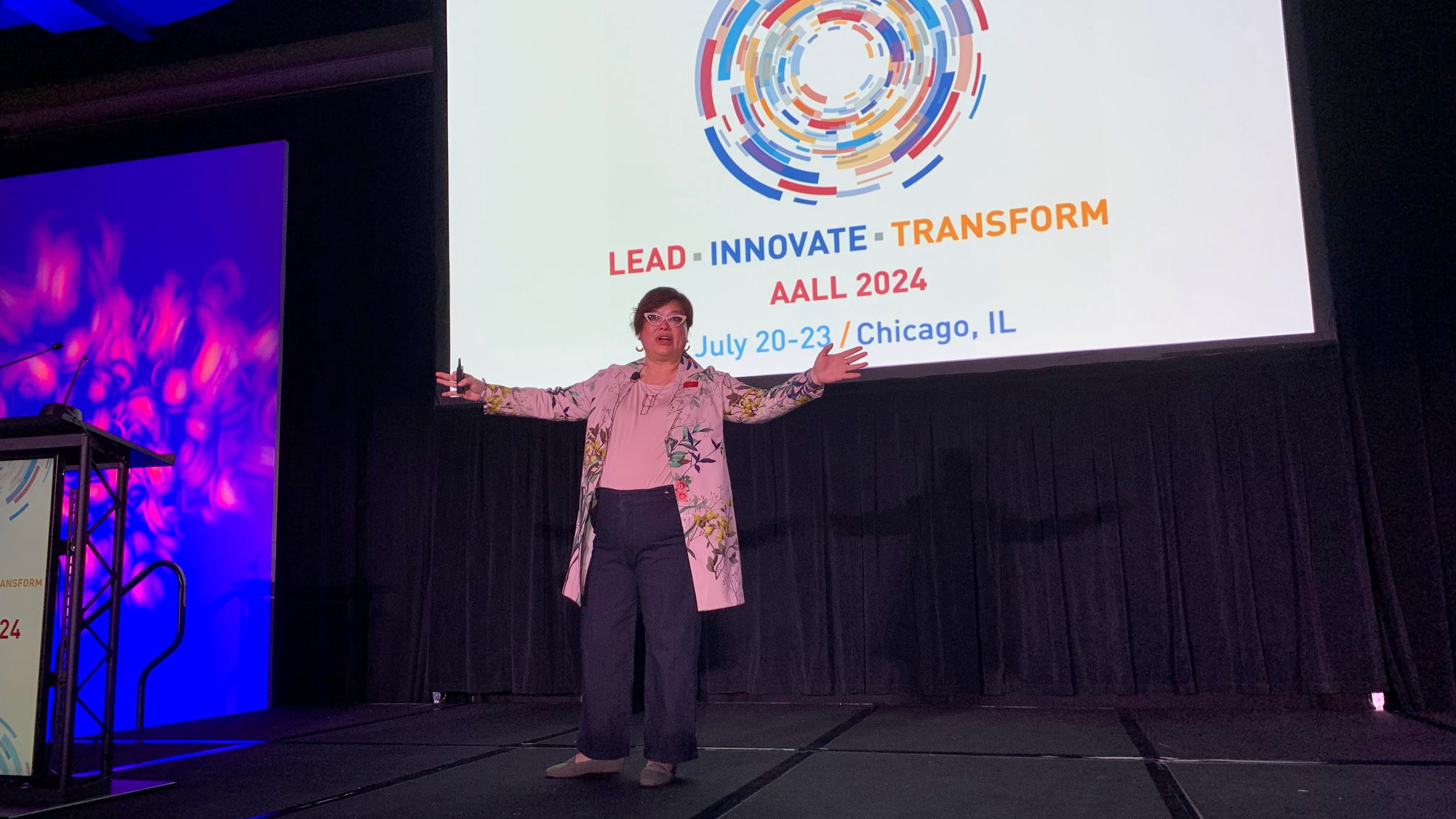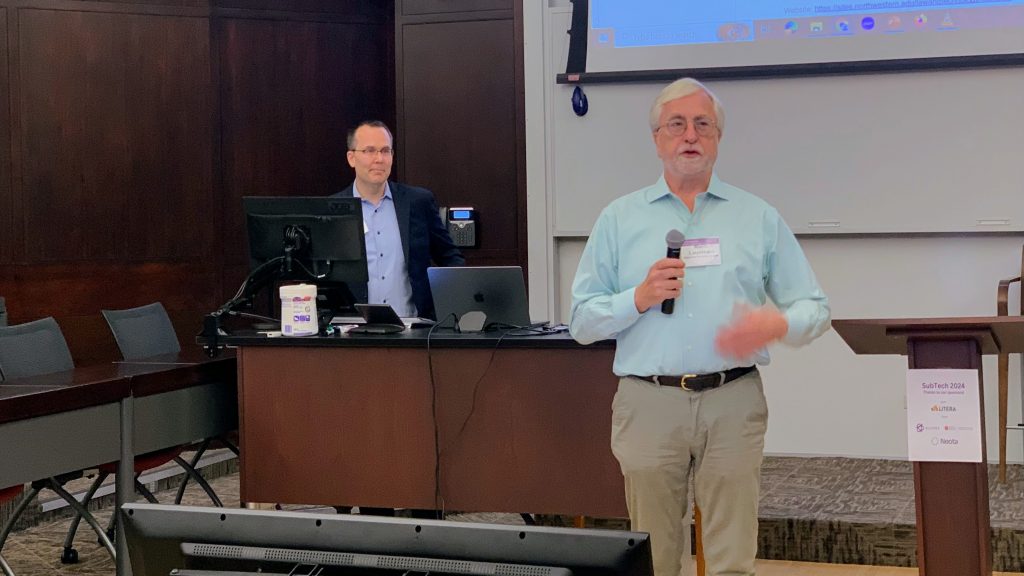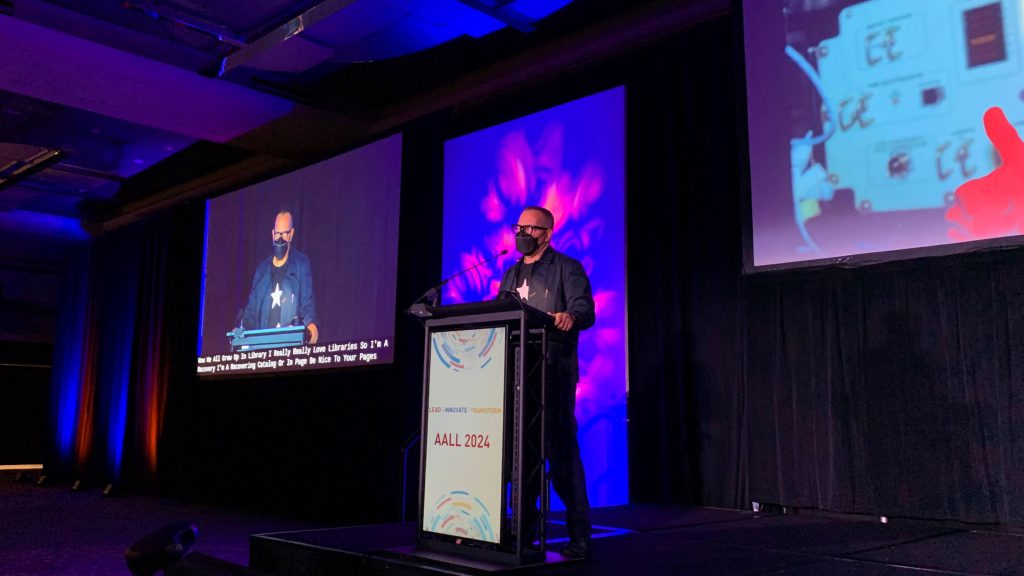Within the span of five days recently in Chicago, I attended two somewhat different conferences, and at each, I found evidence that we are moving the ball forward on developing and implementing practical applications for generative AI in law.
You may wonder why I even needed evidence. After all, for the last year and a half, the legal tech world has been nothing if not about AI. From AI passing the bar, to Thomson Reuters’ acquisition of Casetext, to a steady stream of major AI announcements from companies in every sector of the legal industry, AI has dominated legal tech news.
But in recent months, it has felt as if the AI hype cycle had reached a plateau, or even had peaked and now was dropping. There seemed a sense of malaise, of stagnation. Maybe it was the Stanford study of hallucination rates in LexisNexis and Westlaw that sucked some of the wind out of AI’s sails. There also seemed to be a palpable sense that maybe this is as good as it gets – that the technology that everyone thought would radically change the legal profession might really do little more than change how we summarize long documents or create first drafts.
Having been feeling some of that myself before I arrived in Chicago for the two conferences, I departed the Windy City with a renewed belief that the transformative potential of this technology really is significant, that we still are in the early innings of its development, and that meaningful and substantive work is being done to develop AI and to prepare future generations of lawyers to make effective use of it.
‘Substantive’ Tech at SubTech
This felt most palpable at the smaller of the two conferences I attended. SubTech, which has taken place every other year since 1990, may be the best-kept secret in legal tech conferences. It is small – no more than 50 people were there – and I believe attendance is by invitation only.
The “sub” in the name refers to “substantive,” and the conference is described as “an international multidisciplinary gathering of specialists who work in the confluence of legal education and the technology of law.
Founded by Marc Lauritsen, president of Capstone Practice Systems and a longtime legal tech educator, who remains the conference’s uber-convenor, it was held this year at Northwestern’s Pritzker School of Law and chaired by Daniel Linna, director of the Northwestern Law and Technology Initiative and a senior lecturer at both the law school and the McCormick School of Engineering.
While the focus of the conference is described as the confluence of legal education and practice, the majority of the attendees were from academia – law schools, legal innovation programs, computer science programs, and the like. The format was brisk: a series of sessions, each session organized around a theme, and filled with short 10-minute-ish presentations followed by brief discussion and Q&A.
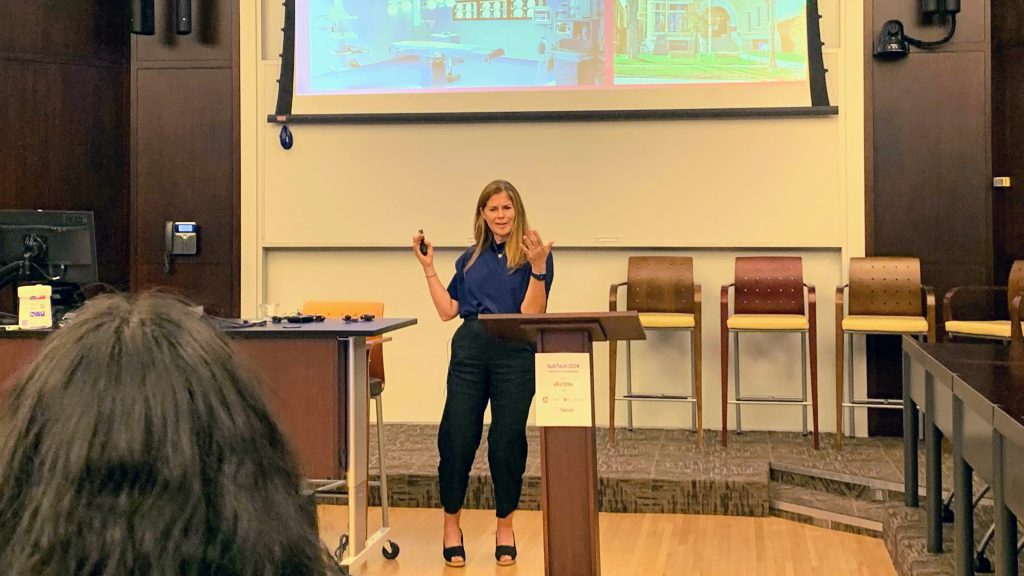
Keynote speaker Bridget Mary McCormack called for ‘radical collaboration’ and ‘radical transparency’ for the legal system to make strides in addressing access to justice.
The tone for the conference was set by keynote speaker Bridget Mary McCormack, the former chief justice of the Michigan Supreme Court who is now president and CEO of the American Arbitration Association.
“The civil justice system in America is a massive market failure,” McCormack declared, bemoaning the fact that most courts have gone back to their pre-COVID practices of providing proceedings only in person and abandoning virtual options.
For the system to change and better serve those who lack access to justice, there needs to be “radical collaboration” and “radical transparency” across the legal system, encompassing courts, bar associations, ADR providers, legal educators, accreditors, and the public.
When asked by an attendee how those working on access to justice can get around the obstacles created by UPL laws, she answered, “Uber didn’t ask permission.” Technology will change our thinking about UPL, she predicted, and said the A2J gap is a “big blue ocean” for lawyers to fish in, but they need to use their imaginations.
Working On the Future
While McCormack was inspiring, the sense of encouragement I came away with was more in the individual presentations over the course of the conference’s two days. It made me see that there are some very smart people who are doing some very important work targeting not the present of AI in law, but the future.
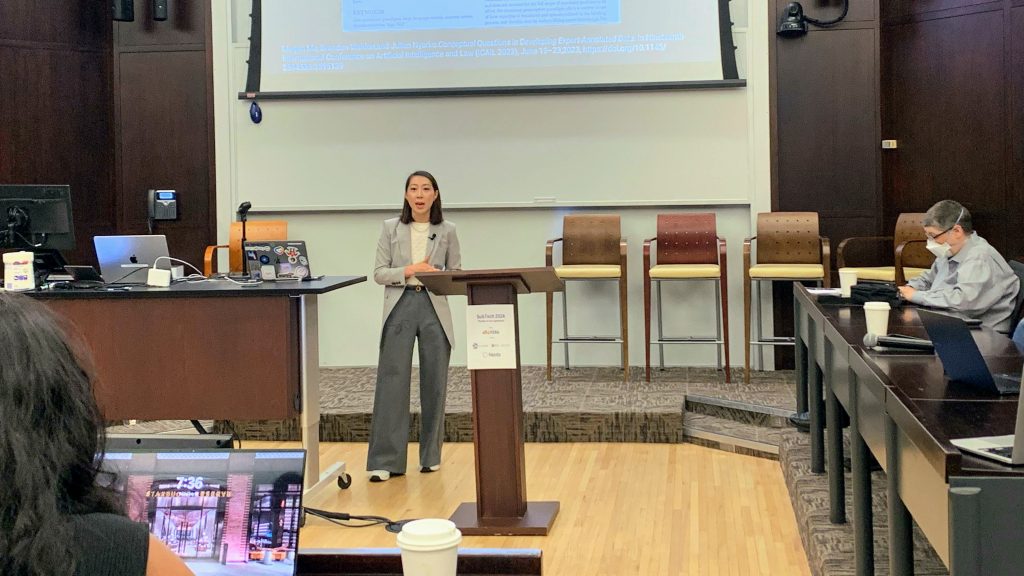
Megan Ma, associate director of the Stanford Program in Law, Science, and Technology and the Stanford Center for Legal Informatics (CodeX), discusses her research.
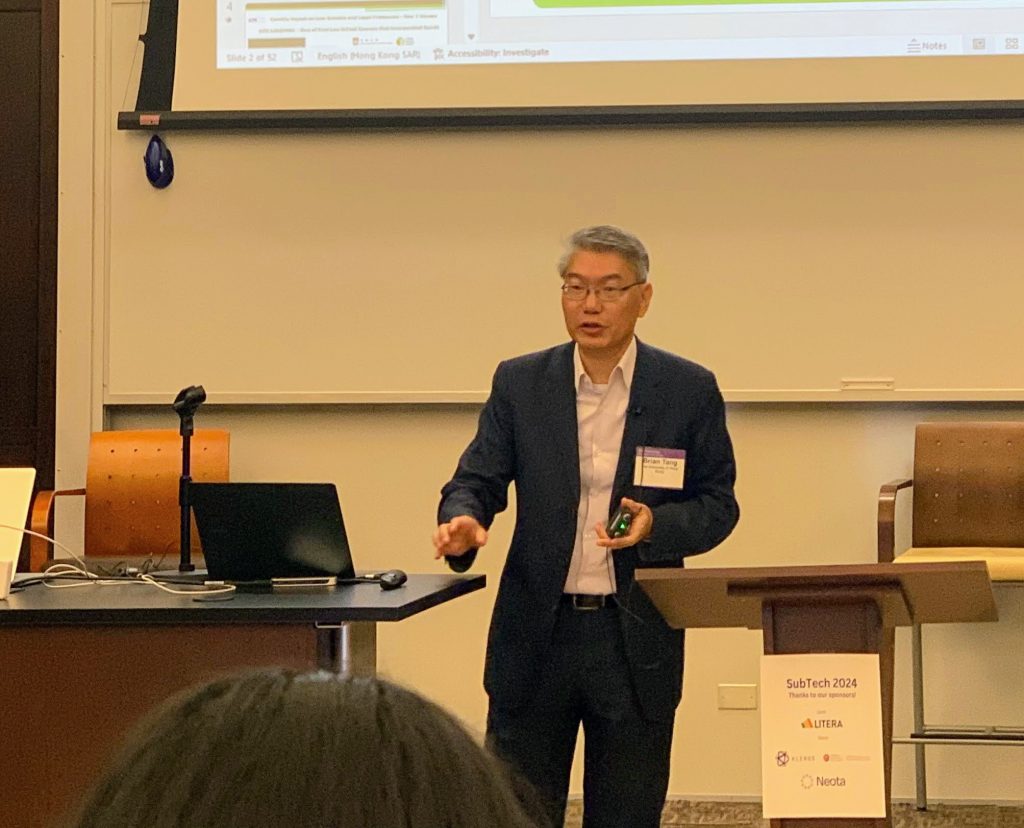
Brian Tang, executive director of LITE Lab@HKU, talks about his work at the University of Hong Kong to develop legal innovation, technology and entrepreneurship.
I regret to admit that so consumed was I by the presentations that my note-taking suffered. And a shared Google Doc for notes looks, in retrospect, somewhat barren. So I am unable to report many of the details I wish I was able to share. However, by way of giving you a taste of what was talked about:
- Megan Ma, associate director of the Stanford Center for Legal Informatics at Stanford Law School, presented on the open source M&A Negotiation Simulator that was just released this week.
- Daniel Schwarcz, professor at the University of Minnesota Law School, talked about his research into whether assistance by generative AI can enhance human legal analysis. (See: Lawyering in the Age of Artificial Intelligence.)
- Samuel Dahan, associate professor of law at Queen’s University and adjunct professor at Cornell Law School, as well as director of the Conflict Analytics Lab, a consortium for AI research on law and conflict resolution, talked his development of OpenJustice, a programmable AI for dispute resolution. He also talked about a recent paper he coauthored evaluating AI for law and calling for open-source legal AI systems.
-
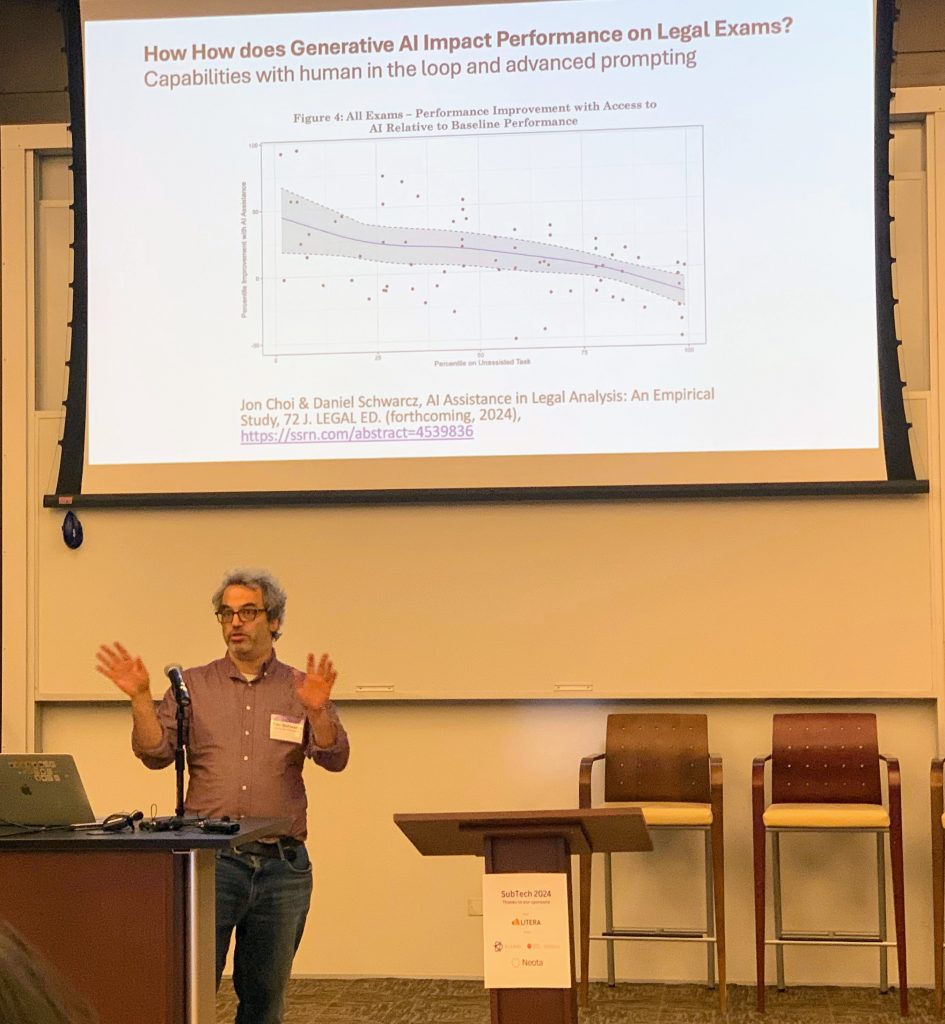
Daniel Schwarcz discusses discussing whether gen AI can impact law student performance on legal exams.
Jaromir Savelka, a research associate at the School of Computer Science, Carnegie Mellon University, and a member of the Technology for Effective and Efficient Learning Lab at CMU, talked about his recent study, It Cannot Be Right If It Was Written by AI: On Lawyers’ Preferences of Documents Perceived as Authored by an LLM vs a Human, which addresses lawyers’ perceptions of AI generated documents.
- Kirsten K. Davis, professor of law and provost’s faculty fellow for generative AI and higher education at Stetson University College of Law, discussed her recent essay, A New Parlor is Open: Legal Writing Faculty Must Develop Scholarship on Generative AI and Legal Writing.
By listing just these few, I am omitting way too many. But I hope you start to get the picture. This was a conference very much focused on the future of AI in law – in law practice, in law schools, and in access to justice – while also focused on the research and experimentation being done today to help guide that future.
Librarians Taking the Lead
After SubTech wrapped up, it was just a short jaunt down the Miracle Mile to the annual convention of the American Association of Law Libraries, which conveniently started the very next day.
If you’ve followed my blog over the years, you’ve seen that I am a big fan of this conference, which, way back in 2017 (at a time when there was not the abundance of legal tech conferences offered today), I described as The Other Legal Tech Conference.
If you want to hang out with a group of people who are thinking hard about the future of AI in law and who are working hard to make that future happen, this is the conference for you.
That may strike some of you as counterintuitive. After all, wasn’t there just a survey last year predicting that gen AI puts law librarians at the risk of obsolescence?
Well, that may be what a survey said, but I never believed it for a second. In fact, as far back as 2020, I wrote a chapter, The Future of AI in Law Libraries, for the book, Law Librarianship in the Age of AI, published by the American Library Association, in which I predicted:
“With greater use of AI and other technologies by legal professionals, the work that law librarians do and the value they provide will become even more important.”
That prediction is being borne out by the facts. An exhaustive AALL survey last year found that, whether they work in law firms or corporate legal, academia or government, law librarians play a central role in testing, recommending and deploying legal technology.
According to the survey:
- 89.1% are involved with testing technology and research products.
- 94.5% are involved with recommending technology and research products for purchase.
- 100% are involved with negotiating library, information resource and database contracts.
Just this week, Jean O’Grady wrote an article, GAI Driving a Hot Job Market for Library and KM Professionals, about a recent Thomson Reuters Institute staffing study showing that law firm staffing rations for library and research staff have spiked upwards in the last year, bucking an across-the-board trend of reduced staffing for other types of support staff.
In her opening remarks at the AALL conference, outgoing president June Hsiao Liebert (pictured in the featured image at the top of this post) echoed this theme, stating that law librarians are no longer just the gatekeepers, but also the innovators, driving adoption of new tools to ensure their organizations thrive in a rapidly evolving landscape.
Where some once questioned whether AI would make law librarians obsolete, Liebert said, they are now asking law librarians to take the lead on this technology, Liebert said.
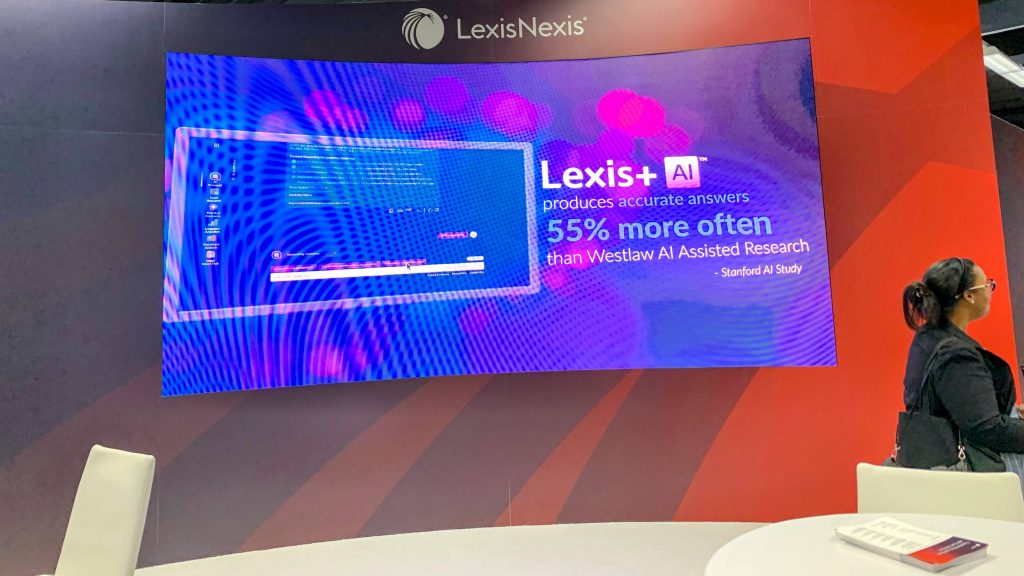
The LexisNexis booth at AALL played up the recent Stanford study of hallucinations in legal research products.
Similarly, keynote speaker Cory Doctorow – who, it turns out, in addition to being a journalist, blogger, science fiction writer and activist, is also a visiting professor of library science at the University of North Carolina – sees hope in law librarians.
Speaking on the “enshittification” of technology platforms, and arguing that enshittification did not spare legal technology platforms, Doctorow said that law librarians can be and need to be part of the cure.
“Librarians,” Doctorow said, “get stuff done.”
So as I boarded the flight to return home from my week in Chicago, I felt a renewed sense of optimism about the future of AI and its promise to transform many aspects of law practice and legal services delivery.
More to the point, I felt that I had just spent a week with many of the people who are making that future happen.
 Robert Ambrogi Blog
Robert Ambrogi Blog